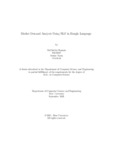| dc.contributor.advisor | Rasel, Annajiat Alim | |
| dc.contributor.author | Hossain, Md Sabbir | |
| dc.contributor.author | Nayla, Nishat | |
| dc.date.accessioned | 2022-05-18T04:36:28Z | |
| dc.date.available | 2022-05-18T04:36:28Z | |
| dc.date.copyright | 2021 | |
| dc.date.issued | 2021-09 | |
| dc.identifier.other | ID 18141007 | |
| dc.identifier.other | ID 21341040 | |
| dc.identifier.uri | http://hdl.handle.net/10361/16634 | |
| dc.description | This thesis is submitted in partial fulfillment of the requirements for the degree of Bachelor of Science in Computer Science and Engineering, 2021. | en_US |
| dc.description | Cataloged from PDF version of thesis. | |
| dc.description | Includes bibliographical references (pages 28-30). | |
| dc.description.abstract | Product market demand analysis plays a significant role for originating business
strategies due to its noticeable impact on the competitive business field. Furthermore,
there are roughly 228 million native Bengali speakers, the majority of whom
use Banglish text to interact with one another on social media. Consumers are buying
and evaluating items on social media with Banglish text as social media emerges
as an online marketplace for entrepreneurs. People use social media to find preferred
smartphone brands and models by sharing their positive and bad experiences
with them. As a result, our goal is to gather Banglish text data and use sentiment
analysis and named entity identification to assess Bangladeshi market demand for
smartphones in order to determine the most popular smartphones by gender. We
scraped data from social media with instant data scrapers and scraped data from
Wikipedia with python web scrapers. Using Python’s Pandas and Seaborn libraries,
the raw data is filtered using NLP methods. To train our datasets for named entity
recognition, we utilized Spacey’s custom NER model, Amazon Comprehend Custom
NER. A tensorflow sequential model was deployed with parameter tweaking
for sentiment analysis. Meanwhile, we used the Google Cloud Translation API to
estimate the gender of the reviewers using the BanglaLinga library. In this article,
we use natural language processing (NLP) approaches and several machine learning
models to identify the most in-demand items and services in the Bangladeshi market.
Our model has an accuracy of 87.99 percent in Spacy Custom Named Entity
recognition, 95.51 percent in Amazon Comprehend Custom NER, and 87.02 percent
in the Sequential model for demand analysis. After Spacy’s study, we were able to
manage 80 % of mistakes related to misspelled words using a mix of Levenshtein
distance and ratio algorithms. | en_US |
| dc.description.statementofresponsibility | Md Sabbir Hossain | |
| dc.description.statementofresponsibility | Nishat Nayla | |
| dc.format.extent | 30 pages | |
| dc.language.iso | en | en_US |
| dc.publisher | Brac University | en_US |
| dc.rights | Brac University theses are protected by copyright. They may be viewed from this source for any purpose, but reproduction or distribution in any format is prohibited without written permission. | |
| dc.subject | Market demand analysis | en_US |
| dc.subject | Sentiment analysis | en_US |
| dc.subject | Natural language processing | en_US |
| dc.subject | Name entity recognition | en_US |
| dc.subject | Tensor-flow | en_US |
| dc.subject | Gender prediction | en_US |
| dc.subject | Banglish Text | en_US |
| dc.subject.lcsh | Computational linguistics. | |
| dc.subject.lcsh | English language -- Data processing. | |
| dc.subject.lcsh | Natural language processing (Computer science) | |
| dc.title | Market demand analysis using NLP in Bangla language | en_US |
| dc.type | Thesis | en_US |
| dc.contributor.department | Department of Computer Science and Engineering, Brac University | |
| dc.description.degree | B. Computer Science | |

